Interplanetary shock wave hits Earth’s magnetic field creating red, yellow, green southern lights and blue northern lights
By
Strange Sounds
-
Apr 22, 2018
When an interplanetary shock wave – a supersonic disturbance in the gaseous material of the solar wind usually delivered by coronal mass ejections (CMEs) – hit Earth’s magnetic field on April 19th, northern skies lit up with electric blue auroras. Southern skies lit up, too, but the palette was different. Peter Sayers sends this photo of red, yellow and green lights over Wilmot, Tasmania:
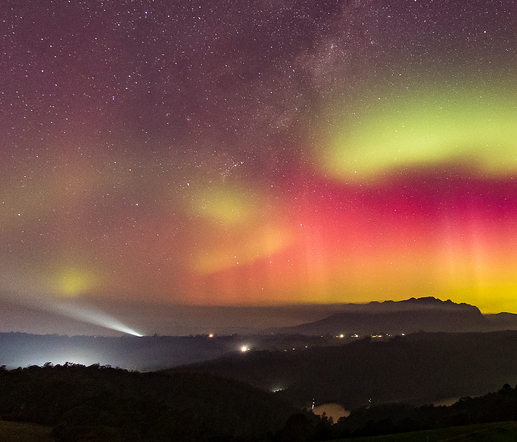 Southern lights captured by Peter Sayers on April 20, 2018 @ Wilmot, Tasmania
Southern lights captured by Peter Sayers on April 20, 2018 @ Wilmot, Tasmania 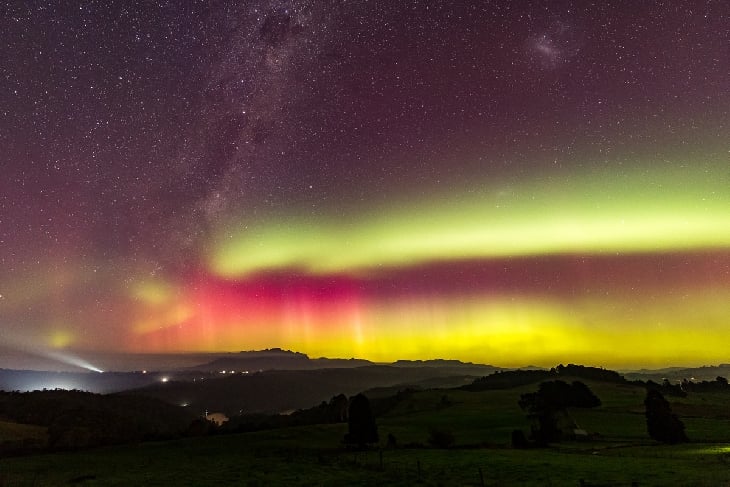 Interplanetary shock wave colors southern sky in red, yellow and green. By Peter Sayers
Interplanetary shock wave colors southern sky in red, yellow and green. By Peter Sayers 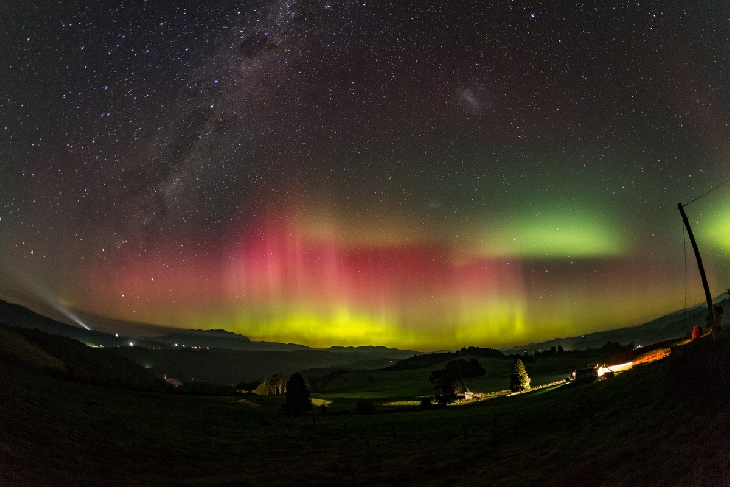 Southern lights captured by Peter Sayers on April 20, 2018 @ Wilmot, Tasmania
Southern lights captured by Peter Sayers on April 20, 2018 @ Wilmot, Tasmania
Similar colors were observed in New Zealand:
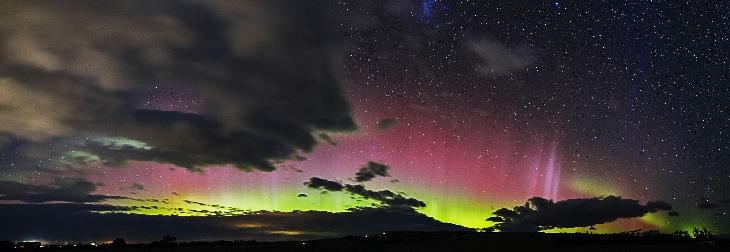 Bright southern lights taken by Paul Stewart on April 20, 2018 @ Timaru, New Zealand
Bright southern lights taken by Paul Stewart on April 20, 2018 @ Timaru, New Zealand  Bright southern lights taken by Paul Stewart on April 20, 2018 @ Timaru, New Zealand
Bright southern lights taken by Paul Stewart on April 20, 2018 @ Timaru, New Zealand
And Antarctic skywatchers witnessed almost pure green:
 Green southern lights captured in Antarctica on April 21, 2018 by B Sudarsan Patro
Green southern lights captured in Antarctica on April 21, 2018 by B Sudarsan Patro 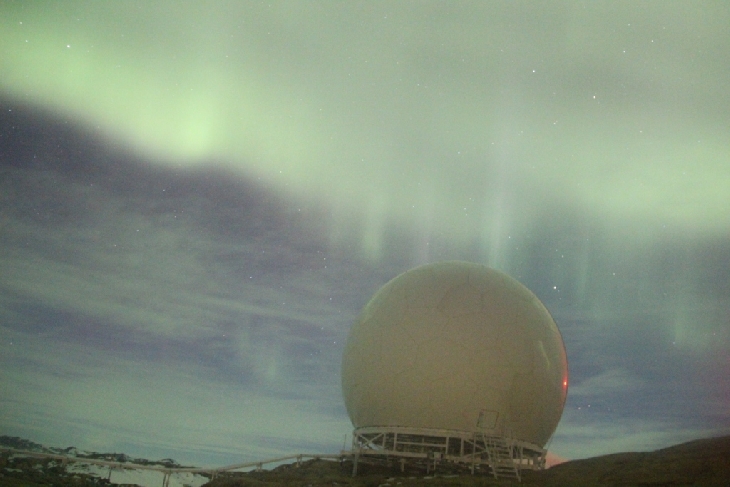 Taken by B Sudarsan Patro on April 21, 2018 @ Bharati Indian Research Base Station, Lasermannhills East Antarctica.
Taken by B Sudarsan Patro on April 21, 2018 @ Bharati Indian Research Base Station, Lasermannhills East Antarctica. 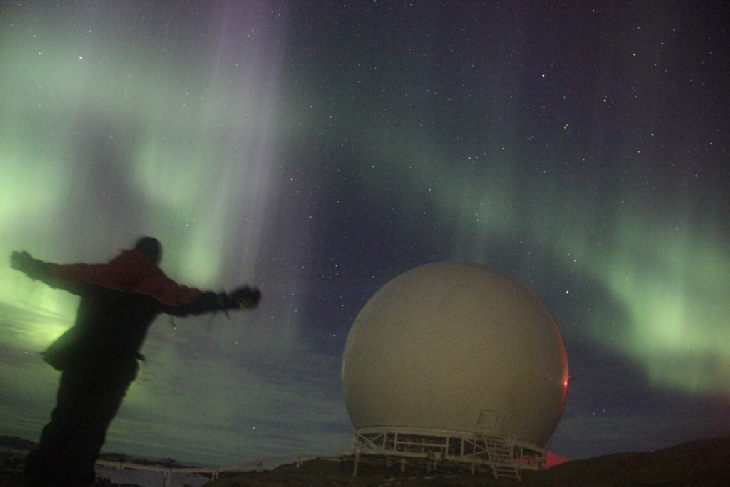 Taken by B Sudarsan Patro on April 21, 2018 @ Bharati Indian Research Base Station, Lasermannhills East Antarctica.
Taken by B Sudarsan Patro on April 21, 2018 @ Bharati Indian Research Base Station, Lasermannhills East Antarctica.
 The same blue hue was observed by Hongming Zheng on April 20, 2018 @ Battle Ground, Indiana
The same blue hue was observed by Hongming Zheng on April 20, 2018 @ Battle Ground, Indiana  Intense blue northern lights taken by Matt Melnyk on April 20, 2018 @ Manitoba
Intense blue northern lights taken by Matt Melnyk on April 20, 2018 @ Manitoba
Southern Lights, on the other hand, were dominated by oxygen. Oxygen atoms glow red and green when excited by incoming particles from space.
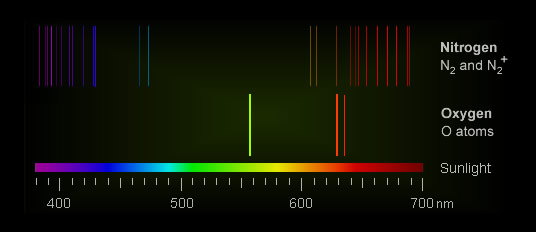 Auroral light is mostly from electronically excited oxygen atoms. Green radiation prevails at low altitudes and red at higher. Excited nitrogen molecules and nitrogen molecular ions produce pink and red at low altitudes.
Auroral light is mostly from electronically excited oxygen atoms. Green radiation prevails at low altitudes and red at higher. Excited nitrogen molecules and nitrogen molecular ions produce pink and red at low altitudes.
Oxygen and nitrogen are abundant in both hemispheres – so why they dominated in different places is anyone’s guess. Consider it a beautiful mystery.
Thanks to: http://strangesounds.org
By
Strange Sounds
-
Apr 22, 2018
When an interplanetary shock wave – a supersonic disturbance in the gaseous material of the solar wind usually delivered by coronal mass ejections (CMEs) – hit Earth’s magnetic field on April 19th, northern skies lit up with electric blue auroras. Southern skies lit up, too, but the palette was different. Peter Sayers sends this photo of red, yellow and green lights over Wilmot, Tasmania:
 Southern lights captured by Peter Sayers on April 20, 2018 @ Wilmot, Tasmania
Southern lights captured by Peter Sayers on April 20, 2018 @ Wilmot, Tasmania  Interplanetary shock wave colors southern sky in red, yellow and green. By Peter Sayers
Interplanetary shock wave colors southern sky in red, yellow and green. By Peter Sayers  Southern lights captured by Peter Sayers on April 20, 2018 @ Wilmot, Tasmania
Southern lights captured by Peter Sayers on April 20, 2018 @ Wilmot, TasmaniaSimilar colors were observed in New Zealand:
 Bright southern lights taken by Paul Stewart on April 20, 2018 @ Timaru, New Zealand
Bright southern lights taken by Paul Stewart on April 20, 2018 @ Timaru, New Zealand  Bright southern lights taken by Paul Stewart on April 20, 2018 @ Timaru, New Zealand
Bright southern lights taken by Paul Stewart on April 20, 2018 @ Timaru, New ZealandAnd Antarctic skywatchers witnessed almost pure green:
 Green southern lights captured in Antarctica on April 21, 2018 by B Sudarsan Patro
Green southern lights captured in Antarctica on April 21, 2018 by B Sudarsan Patro  Taken by B Sudarsan Patro on April 21, 2018 @ Bharati Indian Research Base Station, Lasermannhills East Antarctica.
Taken by B Sudarsan Patro on April 21, 2018 @ Bharati Indian Research Base Station, Lasermannhills East Antarctica.  Taken by B Sudarsan Patro on April 21, 2018 @ Bharati Indian Research Base Station, Lasermannhills East Antarctica.
Taken by B Sudarsan Patro on April 21, 2018 @ Bharati Indian Research Base Station, Lasermannhills East Antarctica.What’s the difference?
Northern Lights stimulated by the shock wave were dominated by ionized nitrogen molecules, which produce a blue glow at the upper limits of Earth’s atmosphere like below: The same blue hue was observed by Hongming Zheng on April 20, 2018 @ Battle Ground, Indiana
The same blue hue was observed by Hongming Zheng on April 20, 2018 @ Battle Ground, Indiana  Intense blue northern lights taken by Matt Melnyk on April 20, 2018 @ Manitoba
Intense blue northern lights taken by Matt Melnyk on April 20, 2018 @ ManitobaSouthern Lights, on the other hand, were dominated by oxygen. Oxygen atoms glow red and green when excited by incoming particles from space.
 Auroral light is mostly from electronically excited oxygen atoms. Green radiation prevails at low altitudes and red at higher. Excited nitrogen molecules and nitrogen molecular ions produce pink and red at low altitudes.
Auroral light is mostly from electronically excited oxygen atoms. Green radiation prevails at low altitudes and red at higher. Excited nitrogen molecules and nitrogen molecular ions produce pink and red at low altitudes.Oxygen and nitrogen are abundant in both hemispheres – so why they dominated in different places is anyone’s guess. Consider it a beautiful mystery.
Thanks to: http://strangesounds.org






 Sat Mar 23, 2024 11:33 pm by globalturbo
Sat Mar 23, 2024 11:33 pm by globalturbo

